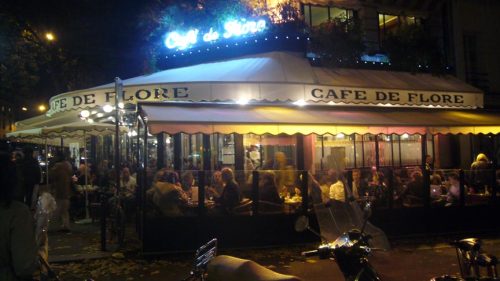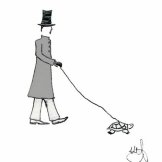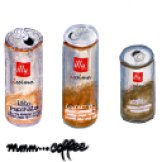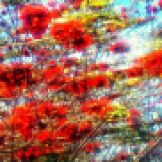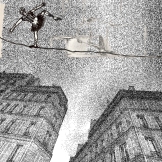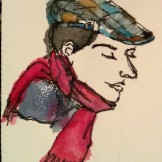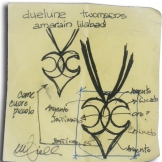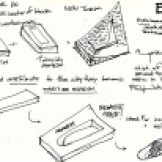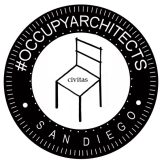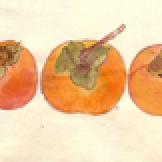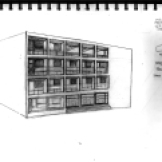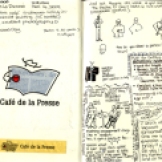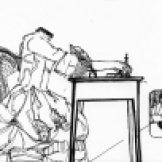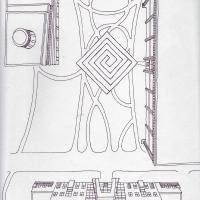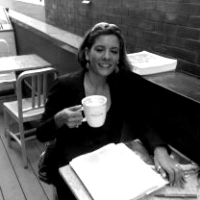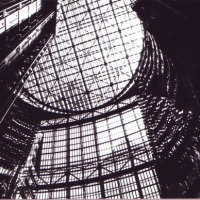Love the question as though rooms lit at night, never visited.
Archive for November, 2011
Love The Questions II
Posted in art,poetry,writing on November 30, 2011| Leave a Comment »
Love The Questions
Posted in art,poetry,writing on November 29, 2011| Leave a Comment »
Have patience with everything unresolved in your heart and try to love the questions themselves as if they were locked rooms or books written in a very foreign language.
Don’t search for the answers, which could not be given to you now, because you would not be able to live them.
And the point is, to live everything.
Live the questions now.
Perhaps then, someday far in the future, you will gradually, without even noticing it, live your way into the answer.
Rainer Maria Rilke “Letters to a Young Poet”
A Blessing
Posted in art,poetry,writing on November 28, 2011| Leave a Comment »
Paris in and after the rain
Posted in art,poetry,writing on November 27, 2011| Leave a Comment »
Having lived in Paris unfits you for living anywhere, including Paris.
John Ashbery (quoted in The Last Avant-Garde by David Lehman)
Fall Bouquet {and a button}
Posted in art, art,poetry,writing, Photography, Poetry, tagged art, bouquet, fall, nest, Photography, poem, Poetry on November 26, 2011| 3 Comments »
Think in images, not sentences anymore
or better, fill yourself with food-sounds
against hollow silences.
Colours are a kind of music
and music pours a red-yellow wine here.
Drink it.
Sit like a cat in the Sun,
this warm December Sun that heals
this warm December Sun that lights
all dusty corners of the soul
and renews.
My California, My South,
My brilliant blessing, I thank you.
Year, rush to an end.
Is it Spring when the birdlets leave the gilded cage?
Open all doors.
Is it Spring when the starlings return from Southern latitudes?
Then burst open shutters and windows
They never do close here.
In the photograph, the hand is like a wing that shelters
It is always there,
in the heart-home
that has no doors
Thinking Deconstructivism in a Canyon
Posted in Architecture, architecture, Articles & Essays, Collage, Cures for the Nothing, Design, Digital Collage, digital collage, photography, writing, architecture, Experiments, F R A G M E N T S, History of Architecture, Lectures, Photography, photography, Quotes, Reading, Research, San Diego, Spontaneous Constructs, Theory and Criticism, Writing, writing, tagged bridges, collage, context, deconstructivist approach, Deconstructivist architecture, defamiliarization., familiar, mark wigley, photomontage, reading on a bridge on November 26, 2011| Leave a Comment »

San Diego, November 25, 2011. Third Avenue Pedestrian Bridge.

San Diego, November 25, 2011. Third Avenue bridge and context (canyon).
” In recent years , the modern understanding of social responsibility as functional program has been superseded by a concern for context. But contextualism has been used as an excuse for mediocrity, for a dumb servility within the familiar. Since deconstructivist architecture seeks the unfamiliar within the familiar, it displaces the context rather than acquiesce to it. What makes it disturbing is the way deconstructivist architecture finds the unfamiliar already hidden within the familiar context. By its intervention, elements of the context become defamiliarized. In one project, towers are turned over on their sides, while in others, bridges are tilted up to become towers.”
Mark Wigley
To Choose a Pair of Gloves
Posted in art, Poetry, Writing, tagged gloves, poem, Poetry on November 23, 2011| 3 Comments »
To choose a pair of gloves
Is serious business.
I place your brown leather small
On top of mine
It is as if you are protecting me
A tender shelter for my hands
Made of florentine winters
cobblestones, morning trains, domes.
It runs a bit short
A black cashmere wrap, or
the vulnerable clinging of the young.
The gloves are empty
Your hands are not there
Your gloves are shells
Echoing your touch
Your gloves are naked
They are the skin you use to protect your skin
I carry them now
I carry you
Then I place mine on top
Brown like yours, but bigger
Your gloves poke from under , happy.
Mother and child of the same tan.
A Directive
Posted in art,poetry,writing, tagged #occupyarchitecture on November 22, 2011| Leave a Comment »
Murmurations {Seven Hundred Sixty Days)
Posted in art, Poetry, Writing on November 20, 2011| Leave a Comment »
The Spoiled
Posted in art, art,poetry,writing, Drawing, Ink, NaBloPoMo, tagged balloon, child, Drawing, ink on November 19, 2011| 2 Comments »
Shelter From The Storm
Posted in art,poetry,writing on November 18, 2011| Leave a Comment »
The Spirit and the Scar
Posted in art,poetry,writing on November 17, 2011| 1 Comment »
The story behind this photo: this was taken at Yoga One studio in San Diego while I was supposed to be in Downward Dog position.
The orange curtains created the most intoxicating reflection on the wooden floor, and the real effect is ten times better that what I captured here. The thing is, this effect is only visible when the lights are turned down, and the room is getting into a meditative mood.
I have to be sneaky, because one can’t disrupt a yoga class in the name of Art. Or can she? I have a dilemma.
I will try again next time and post updates, if I get a better frame. I learned about the term ‘Talkitecture’ tonight. Perhaps this was ‘Talking art”. Tart?
The Secret of the Lost Umbrella | Essay on Orange
Posted in art, Collage, Design, Digital Manipulation, Drawing, Poetry, Writing, tagged collage, delayed bag, Drawing, essay, madrid, manana llovera, markable folding umbrella, michele foyer, muji, my orange, orange, stolen umbrella, umbrella, Watercolor on November 16, 2011| 2 Comments »
I was recently reunited with luggage lost 45 days ago.
Three items were missing: a bottle of Cinema Eau De Parfum by Yves Saint Laurent, a beloved collaged orange umbrella bought in Barcelona and a pair of Sketchers shoes. Go figure.
Immediately i set out to substitute my lost umbrella. As said in one Law and Order episode (I paraphrase): “Hardheaded Calabrese: the people there are very stubborn… once something is taken away from them, they don’t rest until …they get it back.”
My mind went back to the orange umbrella I bought for my mom in Milano last Christmas (probably with her money;)), from one of my favorite stores: Muji.
In my quest, I ran into this glorious essay on a particular shade of orange.
I have a box of orange objects in my house that I have been meaning to combine into a series.
Tomorrow seems like a good day for it, and orange thoughts are perfect for winter-short days and too much yin.
Before you read, keep this in mind:
Fire in Arabic is ‘Nar’.
………….
My Orange
by Michele Foyer
If we lived during the time of the Dutch West Indies Company, I would tell you that the color that so captured me was the child of paprika and chocolate. The world no longer swoons over spice willing to risk a sail beyond the end of the known. And yes, sadly rape and pillage in its desperate greed. I had only to pass the window of the Muji store in Manhattan’s Chelsea to discover this color in an umbrella.
What is it that grabbed me? Is it a vibration for which the color is only a foil? Or is it something about the color itself lodged between memory and desire? This redder orange infused with luxurious chocolate yielded a strangely jazzier yet muter tone than orange. But if we are mapping out its terrain inevitably the orange relation comes up.
My “Muji Orange” is a distant relative of the neon orange of warning, as well as a “tangerine streamlined baby” of sixties psychedelic abandon. Its crazy older paternal cousin might be the Tang of astronauts or maybe the impossible orange of orange Crush soda, or possibly even Blake’s Tyger burning bright, but its doting grandmother, is definitely — yes, most definitely — a bittersweet French marmalade.
There is some mystery to orange. Orange is the only color in the seven-color spectrum besides violet that originates as a noun, naming a particular thing. It refers to the berry fruit of the orange tree, something very concrete and specific and not as abstract as the other colors. Was the experience of the orange fruit so strong that it came to stand for the orange experience?
The Old English Dictionary (OED) states that in Medieval Latin “the forms ‘arangia’, ‘arantia’ (Du Cange) whence ‘aurantia’ have “popular association with ‘aurum’ gold from the colour.” Perhaps, the OED postulates, there is an etymological relationship between the Old French “orenge” for “arauge” after “or” gold. The OED traces the “loss of the initial ‘n‘ in French, English and Italian” as “ascribed to its absorption into the indefinite article” resulting in “narange” absorbing “une” and “narancia” absorbing ”una.”
Also from the OED we understand that the “native country of orange appears to have been the northern frontier of India, where wild oranges are still found and the name may have originated there.” In Late Sankrit the word for orange is “naranga;” in Hindi it is “narangi” (OED, p. 2001)
Is “orange” related to the color of the fruit and/or to gold and the word “ore” (OED, p. 2001)? Are both these not only things, but also perhaps experiences of light? More questions arise as we consider other correspondences that I call “rhymes and ricochets.”
In Persian the world for pomegranate is “nar” (OED, p.2001) which echoes the nar of narange. Is this coincidence or relationship? The OED states it is not certain. Was the “nar” / pomegranate the fateful fruit of the tree in the Garden of Eden myth? It is possible because the pomegranate rather than the apple was the indigenous fruit. If the pomegranate was the tree of knowledge, what was the knowledge that this golden ball embodied? Might it have reflected a relationship of light to dark?
Is there anything other than coincidence to the resonance of the pomegranate which also figures in the myth of Persephone who spends half her days in a descent into Hades when the earth experiences the dark of winter and the other half above ground when the earth experiences the light of spring – alternations or gradients of light and dark?
In one narrative color is dependent upon history and culture. The OED by definition is a history of the English language, tracing the history and values of the western world with its migrations and roots to the East. Today we think oranges are synonymous with the warm climates of Florida and California. We often believe they are indigenous to North America. However, they were planted by conquistador sailors who needed to create supplies of vitamin C to take with them to guard against scurvy on their long sea journeys.
What is orange in cultures outside of the European? In other cultures closed off to our own for so long by the migration and exchange of trade, say the Japanese or Chinese, what is the etymology of the word orange? In Cantonese Chinese (but not in Mandarin), the word for orange is related by sound to the word for gold. At New Year’s the Mandarin orange embodies good wishes for prosperity. Are “gold” and “orange” a conflation of all these color experiences of light?
What about other earlier societies? I wonder whether orange might “rhyme” with “fire.” Fire had the life-giving power that made a large difference to a culture. If gold wasn’t the commodity of value, it might make sense for the word for this experience to be “fire.” Might gold be in part only an imitation of the light of fire?
These richoceting ruminations about gold and fire are vital, because it is precisely the light of gold or fire that starts to go missing in “my” Muji Orange. It is that chocolate brown in addition to the red of the orange that makes the color “step back” toward the shade. Muji Orange recedes from the saturation and almost clear brilliance of an ordinary orange that lags just behind the brilliance of yellow—whether the origin is the light of sun, gold or fire.
Muji is a Japanese company and that perhaps contributes and infuses a measure of its aesthetic into that of the west. The store’s name is related to “mujo” which evokes “transience” in Japanese. I once heard about Japanese “killed colors.” These colors had a little bit of death in them, fading from their original brilliance and glory. I couldn’t find reference to them again but only to the rikuyu colors made from graying. In Muji Orange the quality of orange steps away from the brilliance of the sunny orange into the shade, holding a note of something that is darker. It is not a sinister dark to be avoided but one to be savored like a fine chocolate.
Is my “Muji Orange” so beautiful to me because it captures the life of light and its brilliance — and the life of dark and its recession? To me “Muji Orange” is a kumquat color par excellence. First like the sweet rind of the kumquat there is a “taste” of brilliance and then immediately, almost simultaneously, just as the fruit yields a sour taste, my Muji orange bursts with another very different moody, darker earthy “taste.” Does Muji Orange with its paprika jazzy zest want to dance the tarantula? Is it death or lack of light that gives my Muji color its kick?
I have questioned whether it was the vibration of the color that pulled me into the Chelsea store — the umbrella an extraneous element. But I wonder if the precise color of orange might also be a “rhyme” with the function of “umbrella”? Are the form and the vibration related in the poetry of memory?
Recently I recalled an earlier encounter with umbrellas. When I studied in Madrid in my 20s, I would often take the subway to go downtown to the Turner bookshop. I’d climb the stairs of the appropriately named Sol subway stop that spilled out onto Jose Antonio, emerging more often than not into a scorching sun.
On my way to the bookshop I would pass outside the window of a store that made confectionaries of violets sold in white and purple miniature hatboxes. But my favorite was the neighboring shop entirely devoted to umbrellas with a placard handwritten in a swirly old-fashioned cursive script in the window that read “Manana llovera.” Both its whimsy and its sales-minded craft were not lost in the English translation — “tomorrow it will rain.”
Last December, many years after my sunny Spanish sojourn, when to me it is now irrefutable that night and day, death and life are folded into one another and that Persephone must braid both dark and light — the Muji Orange color caught my eye. Manana llovera. Tomorrow it will rain. Dear Reader, I bought the umbrella.
Bibliographic Note The Compact Edition of the Oxford English Dictionary, Volume I, AO, (Oxford University Press, United States, 1982).
Copyright Michele Foyer. Web: http://michelefoyer.com/news.html
Keys
Posted in art, Paris Diaries, Photography, tagged keys, lock, seine on November 15, 2011| Leave a Comment »
Meditations on the Sun and Moon
Posted in art, Poetry, Writing, tagged moon, poem, salutations, sun on November 14, 2011| Leave a Comment »
Meditations on the Sun and Moon
Hurricane after silence,
The Sun gives liberally —
You cannot trap its warmth:
Love cannot exist in a prison
It is true
But the Sun will always have her one Moon.
Fences in the water are useless
the water will continue to flow-
You can take a horse to it.
You cannot start fires and complain
If you get burned
You cannot sow seeds on puddles, asphalt,
Dirt
And marvel when a plant doth sprout.
A plane cuts the sky
Writes a requiem
Draws parallel light-hopes.
I live for that tender moment at the end of my days
As the sun is in full crescendo glory,
giving the last, sweet ripeness
Her moon rushes to a corner
Small, full of mischief
and twinkling laughter.
San Francisco, November 2011
Read The City
Posted in art,poetry,writing on November 13, 2011| Leave a Comment »
St. Germain Afternoon
Posted in art,poetry,writing on November 12, 2011| 2 Comments »
Beyond Right and Wrong
Posted in Photography, Poetry, tagged Beyond right and wrong, les tuileries, Photograph, poem, Rumi on November 11, 2011| Leave a Comment »
Out beyond ideas of rightdoing and wrong doing
There is a field. I’ll meet you there.
When the soul lies down in that grass,
the world is too full to talk about
language, ideas, even the phrase each other
doesn’t make any sense.
Jalal al-Din Muhammad Rumi
مولانا جلال الدين محمد بلخى
Full Moon Salutations
Posted in art,poetry,writing, Photography, Poetry, tagged glow, moon, moon salutations, Photograph, poem, poetry of the moon on November 10, 2011| Leave a Comment »
I am sorry
For my jumbled mess of thoughts
my contradictions
my ash offerings
I am sorry
for my sterile hips
for burning like a fallow candle
for not fathoming your fullness
(I salute it now).
Penelope undoes at night
her morning’s narrative.
It changes with each day:
two steps forward and one back
is not a step forward.
In fact, it is very much like
marching in place
while wearing a hair shirt.
I am sorry for my darkness
For wanting to hurt you with dandelions
for standing by a ripped promise
like a stubborn stone.
I write because
I have to.
If necessary, I can beg for a pen and paper
to hold again my favorite barbed wire.
(Sylvia Plath tell me again
how much fun it is
to write a poem).
…
I move my arms to caress
the petals of a giant sunflower
Inhale, lenghten
Exhale, melt.
In my raw silence,
my shard-sharp mind, my heart-awareness
forgetfulness is that one wine
I cannot purchase:
The door was ajar
yet I chose not to enter.
“Forgive my thoughts,
for they bloom at night
Nightflower’d orphans
banished by light”.
San Diego, November 2011.
Thinking With My Hands
Posted in architecture, art,poetry,writing, Cures for the Nothing, Digital Manipulation, Drawing, Ink, Poetry, Quotes, Thinking with my hands, tagged art, bell jar, Drawing, Murmurations, Poetry, Quote, starlings, Sylvia Plath, thinking with one's hands, visual poetry on November 9, 2011| Leave a Comment »
“If neurotic is wanting two mutually exclusive things at one and the same time,
then I’m neurotic as hell.
I’ll be flying back and forth between one mutually exclusive thing and another
for the rest of my days.”
Sylvia Plath, The Bell Jar, Chapter 8
I have to thank my colleague Alan Rosenblum for sharing the concept of thinking with one’s hands and the visual poetry of The Mystery of a Murmuration. His advice is to watch this in silence.
Getting Lost in Le Marais
Posted in Photography, Poetry, tagged Beyond right and wrong, dark night of the soul, Giovanni della Croce, Le Marais, Paris, Photograph, Poetry, Rumi, St.John Of the Cross, Sufi and Christian Mystics on November 8, 2011| Leave a Comment »
The Dark Night of the Soul
St John Of the Cross
On a dark night,
Kindled in love with yearnings–oh, happy chance!–
I went forth without being observed,
My house being now at rest.
In darkness and secure,
By the secret ladder, disguised–oh, happy
chance!–
In darkness and in concealment,
My house being now at rest.
In the happy night,
In secret, when none saw me,
Nor I beheld aught,
Without light or guide, save that which burned in my
heart.
This light guided me
More surely than the light of noonday
To the place where he (well I knew who!) was awaiting me–
A place where none appeared.
Oh, night that guided me,
Oh, night more lovely than the dawn,
Oh, night that joined Beloved with lover,
Lover transformed in the Beloved!
Upon my flowery breast,
Kept wholly for himself alone,
There he stayed sleeping, and I caressed him,
And the fanning of the cedars made a breeze.
The breeze blew from the turret
As I parted his locks;
With his gentle hand he wounded my neck
And caused all my senses to be suspended.
I remained, lost in oblivion;
My face I reclined on the Beloved.
All ceased and I abandoned myself,
Leaving my cares forgotten among the lilies.
Where Buildings are Concrete Poems
Posted in Architecture, art,poetry,writing, Le flâneur, Paris Diaries, Poetry, tagged Blue tree, l'arbre bleu, latin quarter, Paris, Passant, Pierre Alechinsky, poem and painting on building side, Yves Bonnefoy on November 7, 2011| Leave a Comment »

No blind facade allowed. Paris, 2011. Intersection between Clovis and rue Descartes. Mural by Belgian artist Pierre Alechinsky, poem by French poet and writer Yves Bonnefoy (2000)
regarde ce grand arbre
et à travers lui,
il peut suffire.Car même déchiré, souillé,
l’arbre des rues,
c’est toute la nature,
tout le ciel,
l’oiseau s’y pose,
le vent y bouge, le soleil
y dit le même espoir
malgréla mort.
Philosophe,
as-tu chance d’avoir arbre
dans ta rue,
tes pensées seront moins ardues,
tes yeux plus libres,
tes mains plus désireuses
de moins de nuit.
Yves Bonnefoy
look at this great tree
and through it,
that could be enough.For even torn up, sullied,
the tree of the street is
all of nature,
all the heavens,
the bird alights there,
the wind moves there,the sun there expresses
the same hope
in spite of death.
Philosopher,
if you are lucky enough to
have trees in your street,
your thoughts will be less arduous,
your eyes more free,
your hands more desirous,
at least at night.
My own translation based on this one.
L’arbre bleu: A concrete poem to Paris
By Cara Waterfall
A luminous, blue tree explodes above the Paris rooftops of the 5ième arrondissement. L’arbre bleu (or the blue tree) is the flâneur’s reward for roaming the streets of Paris in reverie and without a map.
This 2000 mural by Belgian artist Pierre Alechinsky, completed in situ, is at the intersection of rue Clovis and rue Descartes. At Alechinsky’s request, the painting has been accompanied by a poem by his friend and renowned French poet and writer Yves Bonnefoy.
The tree’s radiance is in stark contrast to its metropolitan environment: it is a bright blue column with only a few errant splashes to mar its clean lines; the branches emanate from the trunk like an open palm, fingers outstretched. The image reminds the observer that nature still has a place here – although it is somewhat camouflaged by the crowds and the congestion of buildings.
But the border of this central motif tells another story: Alechinsky, 84, delights in imperfection and the margins provide a narrative of their own. Each block in the border of l’arbre bleu reveals the troubled fragments of this urban world: charred trees have succumbed to civilization and now wilt against the concrete backdrop; bursts of royal blue spatter blemish the other blocks of the frame.
Bonnefoy, 87, has written extensively about the meaning of spoken and written words. His style is unembellished with a simple use of vocabulary that can be misleading: he manages to imbue a sensuality into this sparseness of language. As such, it is the ideal complement to Alechinsky’s l’arbre bleu.
The poem gently intrudes on the individual’s consciousness and suggests that this image is sufficient to begin a dialogue about how humans interact with their environment and specifically, how art can bring us closer to nature. The poet further explains that although it is only the image of a living tree, this “torn, soiled tree of the streets” is vivid enough that a bird perches on it, the wind moves it – even the sun shares its hopeful rays with it.
L’arbre bleu was a natural sequel to Alechinsky and Bonnefoy’s initial collaboration: in 2009 Bonnefoy had written a book about the artist’s pictorial method of expression in Alechinsky, Les traversées (The Crossings). He was well prepared for this text having written numerous essays on the subject. The book also explores his involvement with the CoBrA Group, a radical art movement from 1948 to 1951, of which Alechinsky was one of the founders.
Alechinsky is the sole surviving member of the CoBrA Group. (The name was coined by one of the founders, Christian Dotremont, from the initials of the members’ hometowns: Copenhagen, Brussels and Amsterdam.) The Group was inspired by primitive art and children’s drawings. Their painting is characterised by vibrant colours, and vigorous brushstrokes; this liberty of movement is evident in l’arbre bleu. Critics have dismissed Alechinsky as “the man who grew up to be a child” and his art as infantile scribbling, but this spontaneity is representative of the CoBrA movement.
In the early 1950s Alechinsky became enamoured with oriental calligraphy: this highly stylized way of writing with an ink-wet brush allowed for greater variations in the curve and thickness of the lines he used in his work. His experience as the Paris correspondent for the Japanese journal Bokubi (The Joy of Ink) further informed his artistic methods. But the overriding trait of his art remains the combination of writing and pictorial signs.
The Blue Tree mural in Paris
L’arbre bleu differs from “standard” graffiti in that it was not created under cloak of darkness, but was commissioned; however, it still fits into the category of street art as a political vehicle that is countercultural. The painted tree explores our relationship to nature and underscores the fact that the concrete jungle can be fertile ground for the imagination.
But the real strength of l’arbre bleu lies in its economy: the painted image and the poem are layered with meaning. They articulate that nature can be accessible anywhere. Alechinsky and Bonnefoy have redefined the concrete poem: its lyricism unfolds amid the circuitry of the city – the painted tree no more out of place than a real one would be.
From indietravelpodcast.com.
Boulevards are Poems: Drink in Ideas
Posted in Paris Diaries, Photography, Quotes, tagged boulevards, Edmund White, Ernest Hemingway, Paris, Photography, the flâneur on November 6, 2011| 2 Comments »
Balzac called the boulevards of Paris what the Grand Canal was to Venice,
saying that whoever stepped onto them was lost to their charm:
“on y boit des idees.’ (here people drink in ideas).
Edmund White, The Flaneur
…
” If you are lucky enough to have lived in Paris as a young man,
then wherever you go for the rest of your life it stays with you,
for Paris is a moveable feast.”
Ernest Hemingway
Sketching at Bassam II {and two poems}
Posted in Drawing, Ink, NaBloPoMo, Poetry, Writing, tagged art, Bassam, Ilyas Abu Shabaku, Lebanese poet, literary cafe, modern arabic poetry an anthology, Poetry, san diego, sketching on November 5, 2011| Leave a Comment »
I want to share these two poems by Ilyas Abu Shabaku, which were given to me as a gift. Poetry is a candle in a dark room: our job in this life may just be to burn as bright as torches, as bright and as alive and loud as we can, for each glorious day we have left.
Thousands of candles can be lighted from a single candle, and the life of the candle will not be shortened,
Happiness never decreases by being shared.
Buddha
By Ilyas Abu Shabaku, Lebanese poet (1903-1947)
This beauty, is it yours or mine?
In you I see a person beautiful in love
Like me. And which of us has given me life?
Is it your shape or mine that i love so?
When in my dream I see love’s images
Is it your shadow in my soul or mine?
Love, all of love, dwells in all I see
Whence all this light? Your universal soul?
Did I create you in the world of fancy
Or are you my creator?
Am I the first whom inspiration blessed
Or was it you? Who writes this verse?
Did I write it for you or you for me?
And who in love can be dictated to
And who dictates? Our imaginations blend,
Your soul within my soul, your mind in mine
When things appear obscure to me I see
A doubting shadow dawning in your eyes
When we met first I found my beginning
As if you were a lost part of my being.
Translated by Adam Haydar and Michael Beard
I LOVE YOU
By Ilyas Abu Shabaku, Lebanese poet (1903-1947)
I love you more than human heart can bear
More than a poet dreams or lover feels
You are the perfumed cloud from heaven sent
To rain upon me your enchanted dew;
I feel your heart, your veins flow into mine,
No gap to let the impure world creep in;
My heart confronts your heart, finding its twin,
As two cups meet in one eternal vow;
In us when wine is made to mix with wine,
A blend of perfume, breeze, and dew combine;
My inspiration dwells within your eyes,
And swells when lip on lip instructs my art;
For us the fire rages, though unfed,
Though we are calm, a storm erupts within.
Translated by Adam Haydar and Michael Beard
Beauty Of the Rain {Paris Days}
Posted in Architecture, architecture, art, Photography, Poetry, Writing, writing, tagged art, at the bottom of everything, bright eyes, falling down in the city, Gustave Caillebotte, impressionist paintings, Paris days, Photography, puddles, rain, rainy, reflections, san diego, the city i inhabit., writing in the rain on November 4, 2011| 2 Comments »



Everytime it rains in San Diego, I get giddy.
I used to dislike rainy days but now, they are just…”Paris days.”
The city acquires a new depth, a warm, poetic melancholy.
That feeling of being inside a Caillebotte painting, where the real city, what I see, what i inhabit, what i fall into, is the image in the water; that wet,beautiful canvas. The rain on the asphalth, rivulets, currents, puddles become a mirror that scrambles, abstractizes, seduces….
The rain on the windows when you are sitting in a literary cafe’, and the place becomes a haven not only for the soul (as it usually is), but a toasty, welcoming,peopled orange-glow that will shelter the body in the intemperate, stormy weather. So seeing the sign of the cafe’ in the rain, in the mist, is what the ship, no longer wreck-bound, feels at the first glimpses of the watchtower in the fog, keeper of her dreams and saviour.
It is as though the rain is inside the cafe’. The window panes are frosted and dewy. We could be anywhere. We could be in Paris.
Or all of it sunk in an ocean, a majestic ruin overgrown with algaes and debris. All of it, wooden tables and chairs from Lebanon, credenzas and tapestries from Jordan. The wine, the coffee, the tea jars. They are all tubling down. And us with them.
It is as though we are sinking in a sweet, decadent oblivion. We drink in the atmosphere while we happily drown in a vague past with no memories. Where everything is possible, allowed, forgiven. And everywhere else, outside of this retro submarine, is desert.
Dialogues in an Echo Chamber
Posted in Design, digital collage, photography, writing, architecture, Drawing, Ink, tagged art, comic, Drawing, figure drawing, ghdah alkandari, ink, inner dialogue, kafka, line art, the trial on November 3, 2011| 2 Comments »
This drawing was inspired by this one , by my blogsister Ghadah Alkandari.
Calling All the Heavens
Posted in art,poetry,writing, Photography, tagged art, Cloudy, Drama, gilded statues, Gold, imperial, overcast, Parigi, Paris, Sculpture, Statue, Storm, Temporale, Tenebre on November 2, 2011| Leave a Comment »
Sketchbloom’s mom, Paris, 1967.
Posted in art,poetry,writing, tagged 1967, dizionario italiano-francese, Eiffel tower 1967, Parigi, Paris, Polaroid, portable vintage french italian dictionary on November 1, 2011| 9 Comments »
P.S: It is November 1st and I once again joined NaBloPoMo (National Blog Posting Month)- In their new home Blogher.com.
This year I’m also on NaNoWriMo (30 days and nights of literary abandon!)
Wish me Bonne Chance…











